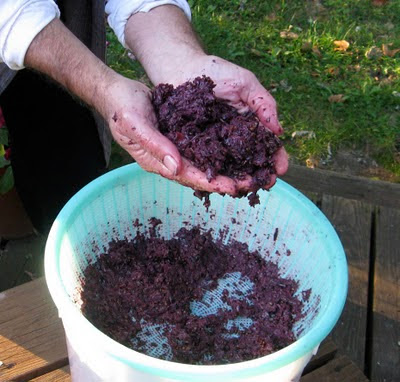 Yield skyrockets; learning curve remains gradual
Yield skyrockets; learning curve remains gradualThe technique I used to preserve grapes through the summer worked too well. In the end, the grapes turned overripe and began to fall off the vine. This outcome is not entirely bad, though.
I managed to extend the season for my young St. Vincent grapevines by shielding them from pests with a gauzy fabric —
We had no losses whatsoever from Japanese beetles, and I did not have to harvest early to preserve the yield from grape-munching birds.
In the deluges of the first half of September, at least 10 inches of rainfall soaked the vineyard, keeping sugar levels low. Throughout late September, Brix levels remained at 15-17. I held out, hoping for 22-23, corresponding to the typical wine alcohol content of roughly 12 percent. Assuming I could stand pat until I ran up against the danger of frost, I allowed plump, heavy clusters grapes to remain on the vines into October.
However, on Sunday, Oct. 3, I encountered an unexpected loss: a few clusters had fallen off the vines and gone splat on the earth below. I learned from my viticulture mentors that this behavior is typical of St. Vincent grapes, which do not necessarily reach optimum sugar levels before they become overripe.
I harvested and processed the grapes immediately.

Grapes: 14 pounds
Brix: 17
Sugar added: about 2 cups
Corrected Brix: 24
Wine: 4 liters (including probably 1 liter of yeasty sludge)
These results, while puny, represent an exponential spike from last year's yield of a total of 74 grapes. Yes, we counted them (It was easy).
Next year, I will set more modest expectations for sugar values and be ready to harvest before fall-off-the-vine syndrome kicks in.
3L wine + 1L sludge.
This year, three of our plants produced grapes. Next year, three more will begin producing. Another two plants are in their first year. So, we're still at least two years away from a potential yield that will allow us to make a 19-liter-carboy batch of wine. The quest continues.


